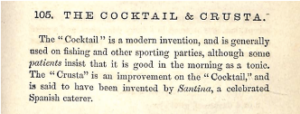Classic Cocktails History
In all ages of the world and in all countries, men have indulged “some social drinks”, as per the British brought the Punch from India in the 17th century. But the term ‘cocktail’ wasn’t really defined until 1806, when The Balance and Columbian Repository of Hudson, New York, described the cocktail as “a stimulating liquor, composed of spirit of any kind, sugar, water, and bitters – it is vulgarly called a bittered sling”.

The Balance and Columbian Repository, May 13, 1806
Cocktails are traditionally thought of as an American innovation, perhaps because of the influence of Jerry “Professor” Thomas or the custom of many thirsty Americans enjoying cocktails in Cuba during Prohibition.
The original cocktail showman, Jerry “Professor” Thomas was an American bartender who worked all over America and at some point also traveled to Europe. He wrote one of the first comprehensive recipe books The Bar-Tender’s Guide – How to Mix Drinks or The Bon-Vivant’s Companion, an encyclopedia of mixed drinks that became a standard-bearer for bartenders.
In his 1862 Bar-Tenders Guide book seems to have a distinct reference between ‘cocktail’ and the ‘crusta’. Back then, a ‘cocktail’ seems to be a style of mixed drink made of spirit, bitters, sugar, and water – as mentioned above by the journal. While ‘crusta’ was another style of mixed drink, not a cocktail as we tend to generalize today – calling all mixed drinks cocktails.

“Bar-Tenders Guide”, Jerry Thomas, 1862
How did drinks become popularized and create such a great culture? Mostly through a form of advertising, the word of mouth. Cocktails have been spread from coast to coast, ordered by aficionados and imbibed in every town.
Giving an updated definition, a cocktail is a mixed drink, alcoholic or non-alcoholic. This can be either a combination of spirits and/or mixed with other ingredients such as juices, syrups, spices, and fruits resulting in a match of flavours.
Bear in mind the old-styles
Punch was made using a mixture of expensive imported ingredients. The alcohol content was provided by rum or brandy, sugar, citrus fruit, spices – usually grated nutmeg – and water were added. Served from elegant large communal bowls into individual glasses or cups.
Daisies are similar to Sours but garnished with fruits in season and applies for raspberry syrup. This means made with 1 part of raspberry or grenadine syrup, 2 parts of lemon or lime, 3 parts of spirit (brandy, rum, whiskey, etc), and topped up with soda water. Served in a short tumbler. On the other hand, Fixes are made with pineapple syrup instead raspberry and served in a larger glass. Both are served over crushed ice.
A Flip is any wine, liquor or spirit shaken with sugar and a whole egg. The usual measures are 1 part of sugar, 1 whole egg, and 3 parts of wine, liquor, or spirit.
The essential in “flips” of all sorts, is to produce the smoothness by repeated pouring back and forward between two vessels, and beating up the eggs well in the first instance; the sweetening and spices according to taste.
Jerry Thomas wrote in his 1862 “Bartenders Guide” that Egg Nogg “is a beverage of American origin, but it has a popularity that is cosmopolitan”. Some folks would have it that the ‘nog’ of Egg Nogg comes from the word ‘noggin’. A noggin was a small, wooden, carved mug which was used to serve drinks in taverns in the 17th century.
Egg Nogg is made similar to ‘Flip’ but with addition of milk and/or cream and are shaken – not “thrown”. This means 1 part of sugar, 1 egg, 1 part of milk and/or cream, and 3 parts of wine, liquor, or spirit. On the other hand, Possets made without egg. Both are garnished with nutmeg.
The Julep is peculiarly an American beverage. Made of fresh mint, sugar, and spirit (whiskey, brandy, rum, etc), Juleps were served in a larger glass than Smashes over crushed ice.
Bucks are similar to a Rickey and a Collins. Is made a quarter of a lemon squeezed into the glass by hand, the lemon itself dropped into the glass, 3 parts of spirit (gin, vodka, brandy, etc), and topped up with soda water. No sugar added. Served in a tall highball glass.
Rickeys are made with half a lime (never with lemon), little or no sugar, liquor or spirit, and filled up with soda water. Served in a medium-sized highball glass.
Collinses are similar to Sour but served in a highball glass and topped up with soda. This means 1 sweet, 2 sour, 3 strong, topped up with soda. This means one measure of sweet can be sugar, or other sweetener; two measures of sour represents lemon, lime, or both; three measures of strong calls for spirit (gin, brandy, vodka, etc), and fill with soda water. The Fizz only differ being served in a medium-sized glass, the same glass as the Rickey.
Cobblers are an American invention. Mainly made with wine (fortified or not), 1 part of sugar, and orange or lemon slices. Served in a large glass over crushed ice and straw.
Cooler is essentially a Horse’s Neck. Pare a lemon so as to leave the rind in one spiral-shaped piece. Place a piece of ice inside the rind, put both into a highball, add the spirit and a cold soda. Stir and serve.
Sangaree is a chilled and sweetened beer, wine, liquor, or spirit served in a highball glass. This means fill a glass with ice, add 1 part of sugar, 3 parts of brandy, shake well and strain, grate nutmeg on top. A Sangaree served with spirit has the obligation to remove the nutmeg – that’s a signature of the Slings.
Both are a mixture of sweet, spirit, and water; both are made with spirits only (gin, whiskey, brandy, etc); both can be served hot or cold. What differ is that only the Sling is grating a little nutmeg on top.
Lemonades are simply made with lemon juice, sugar and water. Can be served hot or cold. Garnished with lemon slices.
Negus is simply sugar, lemon juice, fortified wine (usually Port), hot water, and grated nutmeg. Mulls are made with addition of more spices to taste (cloves, cinnamon, etc).
A Shrub is a ripened mixture of fruit juice, sugar, vinegar and/or hot water. You can also add a liquor or spirit to it. Mix the ingredients into a vessel and cover for a couple of days, strain and then bottle. A great variety of Shrubs may be properly prepared by substituting the kind of liquors and fruits.
Crustas is similar to Cocktail – sugar, water, bitters, and spirit (gin, whiskey, rum, etc) – but change the presentation with the addition of sugar on the rim and a lemon applied like a skirt covering the entire inside-rim glass.
This means, dip the rim in caster sugar; cut a lemon so the peel will all be in one piece; lay the peel in the glass carefully so it will just fit the interior of the glass. Served in a flute
The cocktail named for the crust of sugar on the rim and was invented by Joseph Santini, a bartender from New Orleans.
Cocktails are made by the following recipe: sugar, water, bitters, and spirit (gin, whiskey, rum, etc). Garnish with a squeezed lemon peel.
A Swizzle is a famous West Indian beverage, specially loved by the British. Made in a long glass with crushed ice, some sugar, lime or lemon juice, several dashes of Angostura bitters and a jigger of the desired liquor or spirit. Stirred thoroughly with a swizzle-stick (a small branch with three prongs on the end), and filled up with club soda.
